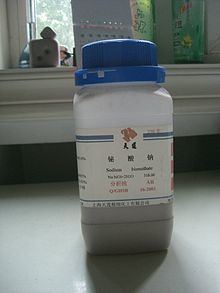Formula NaBiO3 Appearance Light brown powder | Molar mass 279.97 g/mol | |
 | ||
Sodium bismuthate
Sodium bismuthate is the inorganic compound with the formula NaBiO3. It is a yellowish solid that is a strong oxidiser. It is not soluble in cold water, which is sometimes convenient since the reagent can be easily removed after the reaction. It is one of the few sodium salts that is insoluble in water. It is commercially available however commercial samples may be a mixture of bismuth(V) oxide, sodium carbonate and sodium peroxide.
Contents
Structure
Sodium bismuthate adopts an ilmenite structure, consisting of octahedral Bi5+ centers and Na+ centers. The average Bi-O distance is 2.116 Å. The ilmenite structure is related to the corundum structure (Al2O3) with a layer structure formed by close packed oxygen atoms with the two different cations, Na+ and Bi5+ alternating in octahedral sites.
Synthesis and reactions
Bismuth oxidizes to Bi(V) only with difficulty in the absence of alkali. For example, the simple oxide Bi2O5 remains poorly characterized. The preparation of this salt involves oxidizing a mixture of Bi2O3 and Na2O with air (source of O2):
Na2O + O2 + Bi2O3 → 2 NaBiO3The procedure is analogous to the preparation oxidation of manganese dioxide in alkali to give sodium manganate.
It oxidizes water, decomposing into bismuth(III) oxide and sodium hydroxide:
2 NaBiO3 + H2O → 2 NaOH + Bi2O3 + O2It is decomposed more rapidly by acids.
As a strong oxidizer, sodium bismuthate converts virtually any manganese compound to permanganate, which is easily assayed spectrophotometrically. It is also used for lab-scale separation of plutonium.
